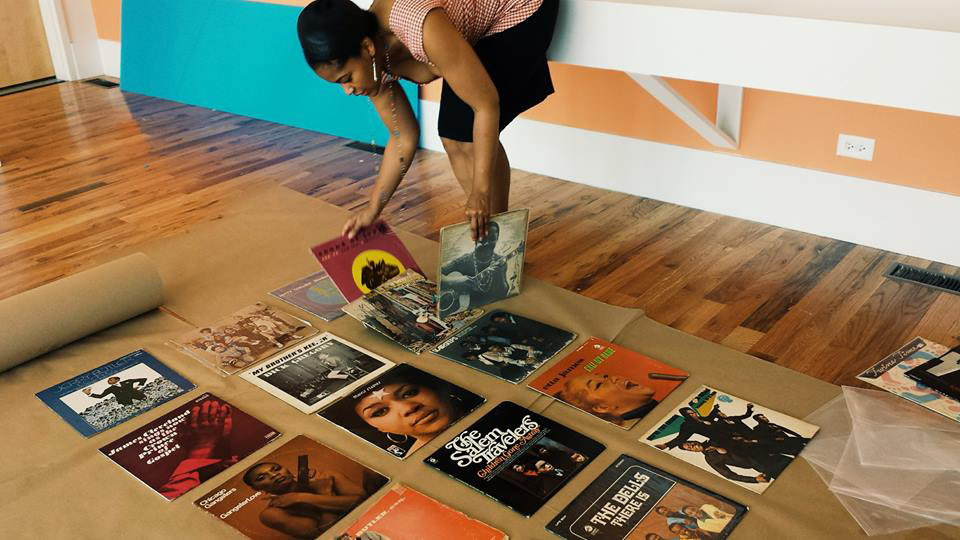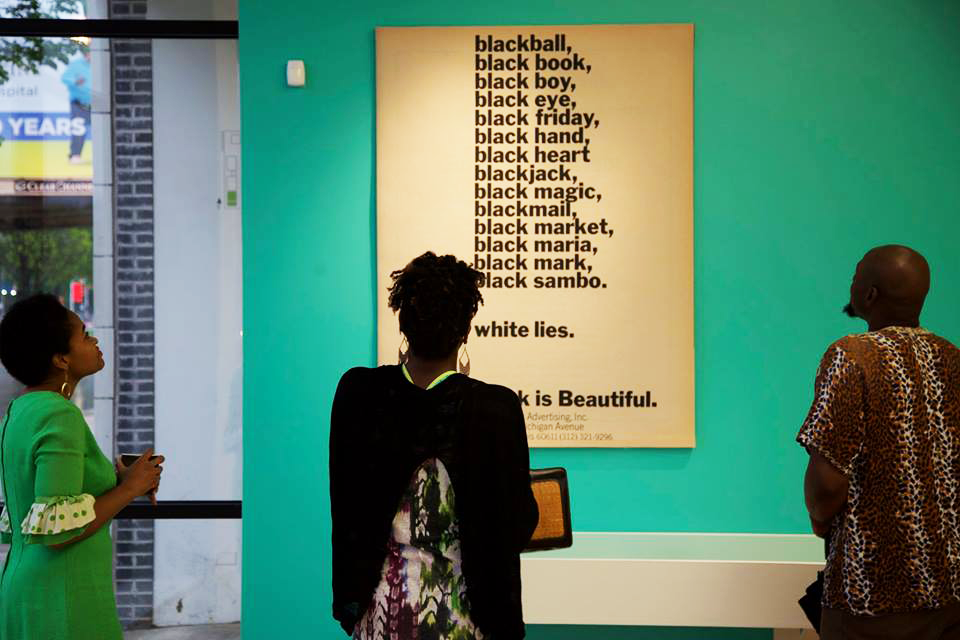The sole physical structure of “Windy City Breakdown” stood in the center of the room—a large wooden frame with glass in the center, displaying rows of album covers like a picture frame holding an old family portrait. The personal record collection of Ayana Contreras, artist-in-residence at the Arts Incubator, is exactly that: a family portrait of Chicago’s musical influencers that stands as a lasting representation of the city’s narrative.
The exhibit closed just a few days ago, but its most obviously displayed works were the case of records and large provocative posters. The rest of the artifacts were strategically placed in white cases lining the walls, displaying photographs, 45 rpm records, and documents from Chicago’s musical past. At her talk on May 19, Contreras explained, “When people ask what I do, I say I collect old stuff to hopefully create new stuff.” Contreras has spent her entire life surrounded and fascinated by what we now call “old stuff.” From rebelliously sifting through her grandmother’s record collection to building her own collection from the inventory of Imports, the record store her mother worked in, Contreras matched the beat of her drum to the sounds of contemporary and past jazz, blues, and choruses.
As she grew older, she began forming her own record collection, often finding her grandmother’s favorites in local shops. She became invested in collecting collections when she began uncovering the collections of strangers; her first bout of secondhand archiving came through discovering numerous records in different shops marked with the initials “S.B.” In the process, she realized that most of the music she was drawn to hailed from Chicago and was from a certain time period—the sixties and seventies, when Black Power in Chicago was alive and well.

“When you find these things, what I’m thinking about is the city of Chicago and our cultural heritage,” Contreras said. “It’s easy to live in my community and think that we don’t have a lot of culture.” While music was at the heart of the exhibition, the display of the culture that the music preserves was its real aim. The large posters hanging from the walls were actually enlarged versions of advertisements displayed during the first Black Expo in 1971, a public fair of black culture aimed at benefiting black businesses and raising awareness about black issues. Each display acted as a chapter in the narrative of the South Side and the city as a whole, holding letters or issues of Jet and Hue from the seventies. It’s an immersion in the South Side as it stood in earlier times, and it draws out the way the climate of the city manifested itself as an inherent characteristic of Chicago music.
The immersive effect of the exhibition stems from Contreras’s deep involvement in current South Side and Chicago music as a DJ on Vocalo, a sister station of WBEZ. As part of her program, Contreras conducts interviews with musicians of the past, and brings them to the ears of listeners in the present. Segments of her interviews are included in her exhibition—a pair of wireless headphones rested on a post to the right of the frame of records. From the music of Syl Johnson to memories of an earlier, more prosperous South Side, the excerpts add another layer to the exhibition: an exposition of the effect that the everyday lives and situations of not only the artists, but also the neighborhoods, had on the culture back then.
Though appreciative of the past, “Windy City Breakdown” is not meant to be nostalgic. Through these archives and interviews, Contreras attempts to use the past to push forward. “There was some serious progress going on, and I feel that this progress has been circumvented,” she said. Even the color of the walls reflects this sentiment—Contreras selected vibrant, but slightly subdued hues because she wanted the walls to “make it feel like there’s an energy.” She hopes that these works can use that energy to mobilize today’s youth. “Working with kids and playing them these records…” Contreras stopped and cleared her throat. “A lot of them don’t have a lot of hope.”
Later in the talk, she stopped, as she had done many times, to play the audience a song: “Motherless Child” as performed by the Operation Breadbasket Orchestra and Choir and Ben Branch. She stopped the track, stating that she and many others in the community at times related to “feeling like a motherless child, where you don’t belong where you are, and you try to create this narrative where black is beautiful and anything is possible…I feel like Chicago is still that place for a lot of people.”
Contreras’s remark explained why the exhibition was at heart a celebration of black advancement through the arts. Though at times it can be hard to register the stories and events represented by the materials in “Windy City Breakdown” without deep familiarity with the particular subject, the overarching aim of the exhibition is palpable—presenting the cultural influence of the time, understanding it as a mobile force, and restoring that to the present to better the futures of black lives.
“I mean, look at Black Twitter, right?” Contreras added. “I think we’re all still trying to find this place where we feel like we all belong.”


Nice article. I’d love to see more articles from Ms. Williams in this publication.
Very interesting.
When I saw Emmett McBain amd Vince Cullers’ “White Lies” ad, I thought the article would mention something about its original source. I consider it by far the greatest ad for an ad agency ever…and one of the best ads ever done…period.
In fact, I included it in my “Invisible Man in the Gray Flannel Suit” expose of the…er…uh…”colorlessness” of the ad agency biz. I wrote
It for PRINT Magazine in 1993. I featured Emmett in my book, “African Americans in Chicago”.
Maybe now I finally have a reason to check out the U of C/Theaster Gates’ “Arts Incubator”.